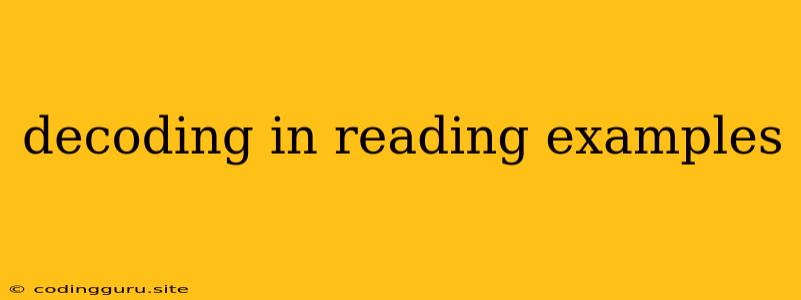Decoding in Reading: Cracking the Code to Comprehension
Decoding in reading is the foundation of literacy, the process of transforming printed symbols into spoken language. It's the bridge between the visual and auditory realms, allowing us to decipher the written word and ultimately understand its meaning. But what does decoding truly entail, and how can we effectively teach and learn this essential skill?
What is Decoding?
Decoding is essentially breaking the code of written language. It involves recognizing letters and sounds, blending those sounds together to form words, and understanding the meaning behind the words. It's a multifaceted process that requires a deep understanding of phonemic awareness, letter-sound correspondence, and sight words.
The Building Blocks of Decoding:
1. Phonemic Awareness: This is the ability to hear, identify, and manipulate individual sounds (phonemes) within words. It's the foundation of decoding, enabling readers to break down words into their constituent sounds.
Example: The word "cat" has three phonemes: /k/, /æ/, and /t/. Recognizing these individual sounds is the first step in decoding the word.
2. Letter-Sound Correspondence: This is the connection between letters and their associated sounds. Knowing that "c" often makes the /k/ sound, "a" typically makes the /æ/ sound, and "t" makes the /t/ sound, allows readers to translate letters into sounds.
3. Sight Words: These are words that are recognized instantly, without needing to be sounded out. They are frequently encountered words that are learned through repeated exposure.
Example: Words like "the," "a," "and," "you," and "said" are commonly considered sight words.
Decoding in Action: Examples
Let's take the word "dog" as an example.
- Phonemic Awareness: We recognize that "dog" has three distinct sounds: /d/, /ɒ/, and /g/.
- Letter-Sound Correspondence: We know that "d" makes the /d/ sound, "o" makes the /ɒ/ sound, and "g" makes the /g/ sound.
- Blending: We blend these sounds together to form the word "dog."
This simple process allows us to decode the word "dog" and access its meaning.
Decoding Strategies:
1. Sounding Out: This involves breaking words into their individual sounds and blending them together.
2. Chunking: This strategy involves dividing words into smaller, meaningful units.
3. Using Context Clues: Surrounding words and sentences can provide clues to the meaning of an unfamiliar word.
4. Visual Cues: Looking at the structure of a word, including letter patterns and familiar parts, can aid in decoding.
The Importance of Decoding:
Decoding is critical for reading fluency and comprehension. When we can decode words effortlessly, we can focus our attention on understanding the meaning of the text.
Decoding Challenges:
Decoding can be challenging, especially for emerging readers. Some common difficulties include:
- Phoneme Isolation: Struggling to identify individual sounds within words.
- Letter-Sound Correspondence: Confusion about the sounds different letters can make.
- Blending: Difficulty putting sounds together to form a word.
- Sight Word Recognition: Not being able to instantly recognize frequently used words.
Tips for Improving Decoding Skills:
- Practice phonemic awareness activities: Sing songs, play games, and engage in activities that focus on identifying and manipulating sounds.
- Introduce letter-sound correspondence systematically: Teach letters and their sounds in a clear and sequential manner.
- Use multisensory methods: Incorporate visual, auditory, and kinesthetic techniques to reinforce letter-sound relationships.
- Encourage repeated reading: Encourage children to read the same text multiple times to build fluency and confidence.
- Use picture dictionaries: Help readers learn new words by connecting them to their visual representations.
Decoding: A Lifelong Skill:
While decoding is particularly important in the early stages of learning to read, it's a skill that continues to be essential throughout life. As we encounter new and unfamiliar words, decoding allows us to access their meaning and expand our vocabulary.
Conclusion:
Decoding is the key to unlocking the world of reading. By understanding the building blocks of decoding, practicing decoding strategies, and addressing any challenges, we can empower readers to navigate the written word with confidence and fluency. Decoding is more than just a skill; it's a gateway to knowledge, imagination, and a lifetime of reading joy.
